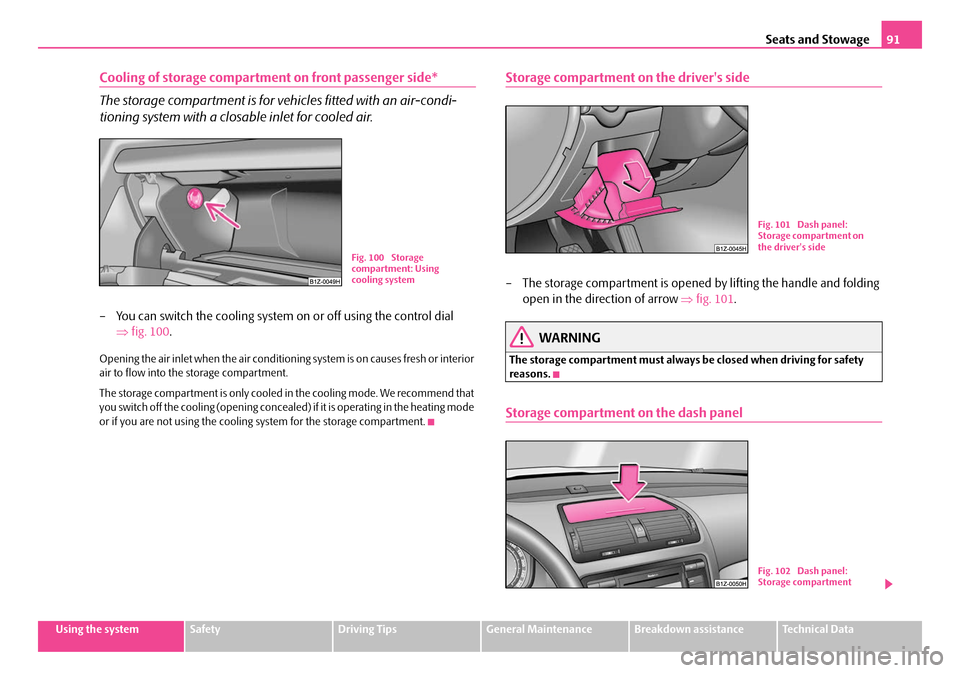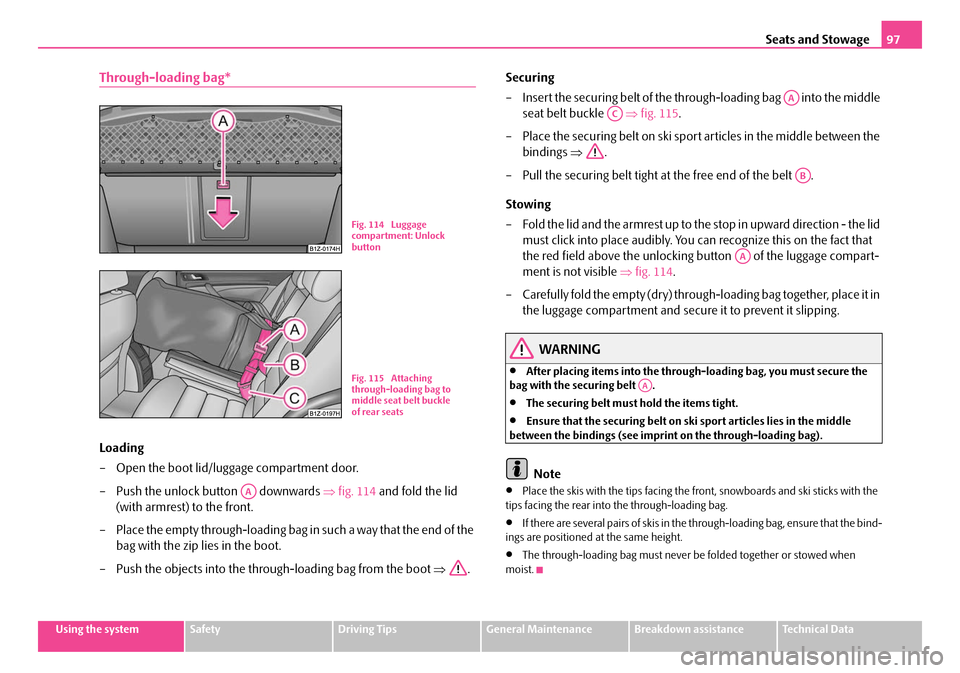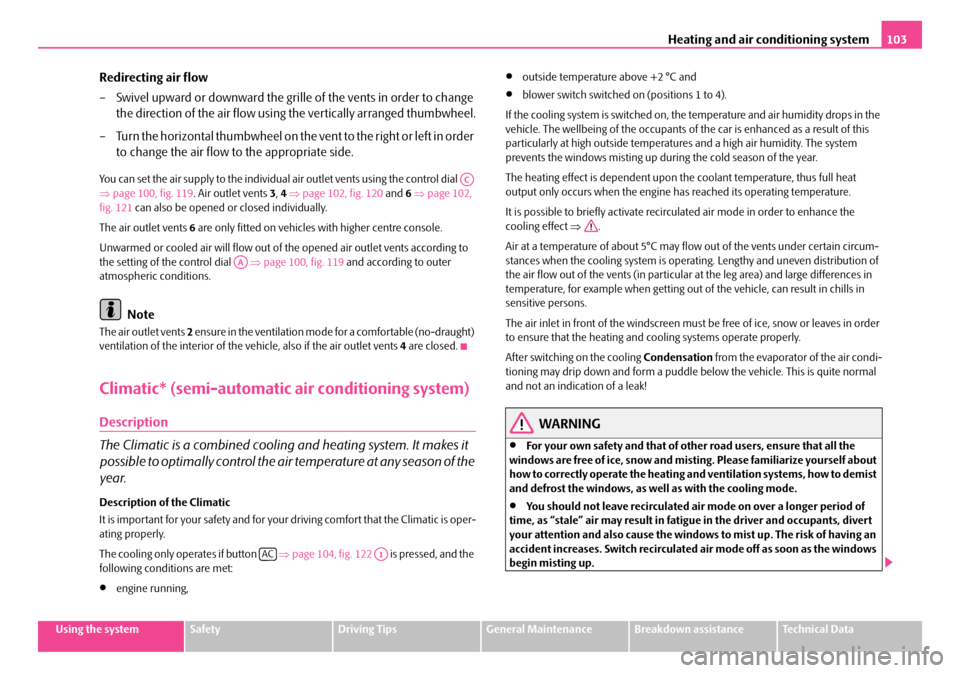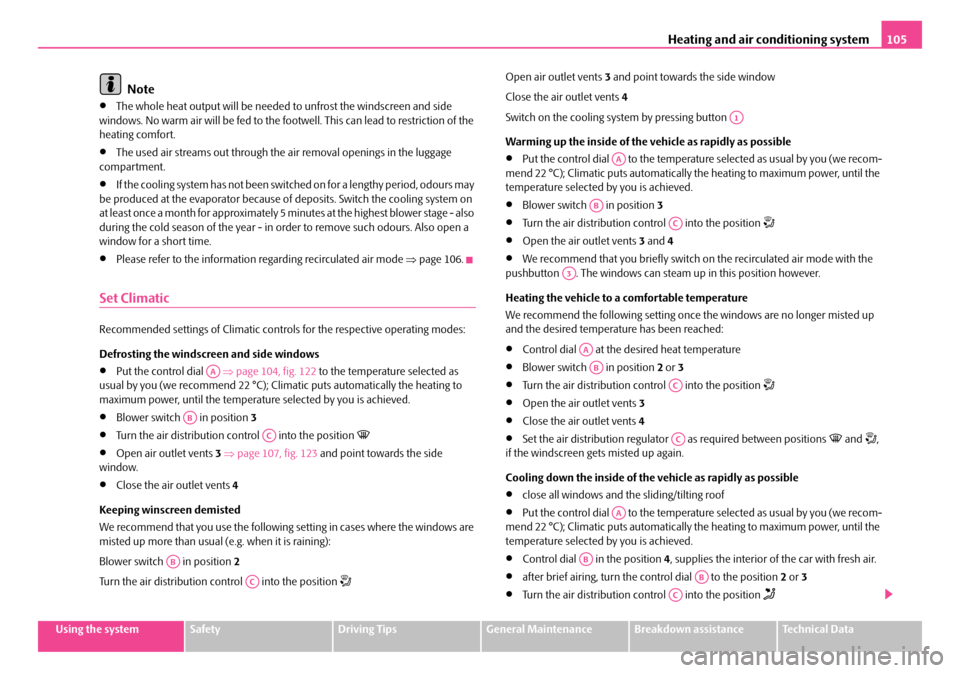technical data SKODA OCTAVIA 2007 1.G / (1U) Service Manual
[x] Cancel search | Manufacturer: SKODA, Model Year: 2007, Model line: OCTAVIA, Model: SKODA OCTAVIA 2007 1.G / (1U)Pages: 288, PDF Size: 15.19 MB
Page 88 of 288

Seats and Stowage87
Using the systemSafetyDriving TipsGeneral MaintenanceBreakdown assistanceTechnical Data
Note holder
The note holder is designed e.g. for atta ching a car park ticket in parking areas.
The attached note has to always be removed before starting off in order not to
restrict the driver's vision.
Ashtray
Front ashtray
Opening ashtray
– Press on the bottom part of the cover of the ashtray - refer to ⇒page 87, fig. 94 .
Removing ashtray insert
– Press on the ashtray insert in the area (the insert comes out) and you can take it out.
Insert ashtray insert
– Insert the ashtray insert into the mount and press it in.
WARNING
Never lay flammable objects in the ashtray basin - risk of fire!
Rear ashtray - low centre console
Opening ashtray
– Grasp the ashtray cover at the lower edge and fold it open in the direction of arrow ⇒fig. 95 .
Fig. 93 Windscreen:
Note holder
Fig. 94 Centre console:
Front ashtray
AA
AB
Fig. 95 Low centre
console: Rear ashtray
AA
NKO A5 20 MR08.book Page 87 Wednesday, April 11, 2007 2:54 PM
Page 90 of 288

Seats and Stowage89
Using the systemSafetyDriving TipsGeneral MaintenanceBreakdown assistanceTechnical Data
Using the power socket
– Take out the cigarette lighter.
– Insert the plug of the electrical a ppliance into the socket of the ciga-
rette lighter.
The 12 volt power socket can also be used to supply power to electrical accessories
with a power uptake up to 180 watts.
WARNING
•Take care when using the cigarette li ghter! Not paying proper attention
or incorrect use the cigarette lighter in an uncontrolled manner may result in
burns.
•The cigarette lighter and the power so cket also operates when the igni-
tion is switched off or the ignition key withdrawn. You should therefore
never leave children unattended in the vehicle.
Caution
Always use matching plugs to av oid damaging the power sockets.
Note
•Connecting electrical components when the engine is not running will
drain the battery of the vehicl e - risk of battery draining!
•Further information ⇒page 229, “Accessories, chan ges and replacement of
parts”.
Power socket in the luggage compartment (estate car)
– Open the cover of the power socket ⇒fig. 98 .
– Connect the plug of the electrical appliance to the socket.
You can only use the power socket for the connection of approved electrical acces-
sories with a power uptake up to 180 watt s. The vehicle battery will be discharged
in the process if the engine is stationary.
The same remarks apply here as for ⇒page 88.
Further information ⇒page 229, “Accessories, changes and replacement of
parts”.
Storage compartments
Overview
You will find the following storag e facilities in your vehicle:
Storage compartment on the front passenger side⇒page 90
Storage compartment on the driver's side⇒page 91
Storage compartment on the dash panel⇒page 91
Fig. 98 Luggage
compartment: Power
socket
NKO A5 20 MR08.book Page 89 Wednesday, April 11, 2007 2:54 PM
Page 92 of 288

Seats and Stowage91
Using the systemSafetyDriving TipsGeneral MaintenanceBreakdown assistanceTechnical Data
Cooling of storage compartment on front passenger side*
The storage compartment is for vehicles fitted with an air-condi-
tioning system with a closable inlet for cooled air.
– You can switch the cooling system on or off using the control dial
⇒fig. 100 .
Opening the air inlet when the air conditioning system is on causes fresh or interior
air to flow into the storage compartment.
The storage compartment is only cooled in the cooling mode. We recommend that
you switch off the cooling (opening concealed) if it is operating in the heating mode
or if you are not using the cooling system for the storage compartment.
Storage compartment on the driver's side
– The storage compartment is opened by lifting the handle and folding
open in the direction of arrow ⇒fig. 101 .
WARNING
The storage compartment must always be closed when driving for safety
reasons.
Storage compartment on the dash panel
Fig. 100 Storage
compartment: Using
cooling system
Fig. 101 Dash panel:
Storage compartment on
the driver's side
Fig. 102 Dash panel:
Storage compartment
NKO A5 20 MR08.book Page 91 Wednesday, April 11, 2007 2:54 PM
Page 94 of 288

Seats and Stowage93
Using the systemSafetyDriving TipsGeneral MaintenanceBreakdown assistanceTechnical Data
Storage compartment in the front doors
A bottle holder is located in the area of the storage compartment for the front
doors.
WARNING
Use the area ⇒fig. 105 of the storage compartment only for storing
objects which do not project so that the effectiveness of the side airbag is not
impaired.
Stowage compartment below front passenger seat*
The storage compartment is foreseen for storing small objects of up to 1,5
kg. in weight.
– Tilt the lock to open the flap and pull out the flap ⇒page 93, fig. 106 .
– Tilt the lock to close the flap and press flap close.
Front seat armrest with storage compartment*
The armrest is adjustable for height and length.
Opening stowage compartment
– Open the lid of the armrest in the direction of arrow ⇒fig. 107 .
Fig. 105 Storage
compartment in the front
doors
AB
AA
Fig. 106 Front passenger
seat: Storage compart-
ment
Fig. 107 Armrest:
Storage compartment
Fig. 108 Armrest:
Cooling of storage
compartment
NKO A5 20 MR08.book Page 93 Wednesday, April 11, 2007 2:54 PM
Page 96 of 288

Seats and Stowage95
Using the systemSafetyDriving TipsGeneral MaintenanceBreakdown assistanceTechnical Data
Seat backrest with opening for skis*
After folding open the armrest and the lid, an opening in the seat backrest
becomes visible through which you can push long objects e.g. skis etc.
You can fold open the armrest and the lid from the passenger or luggage
compartment.
Opening from passenger compartment
– Fold down the armrest of the rear seat at the loop ⇒page 74, fig. 69 .
– Pull the handle up to the stop in upward direction and fold open the lid downwards ⇒fig. 110 . Opening from luggage compartment
– Push the unlock button downwards
⇒page 95, fig. 111 and fold
the lid (with armrest) to the front.
Closing
– Fold the lid and the armrest up to the stop in upward direction - the lid must click into place audibly.
Ensure that the armrest is always locked into place after closing. You can recognize
this on the fact that the red field abov e the unlocking button of the luggage
compartment is not visible.
Fig. 110 Rear seats:
Handle of lid
Fig. 111 Luggage
compartment: Unlock
button
AA
AA
NKO A5 20 MR08.book Page 95 Wednesday, April 11, 2007 2:54 PM
Page 98 of 288

Seats and Stowage97
Using the systemSafetyDriving TipsGeneral MaintenanceBreakdown assistanceTechnical Data
Through-loading bag*
Loading
– Open the boot lid/luggage compartment door.
– Push the unlock button downwards ⇒fig. 114 and fold the lid
(with armrest) to the front.
– Place the empty through-loading bag in such a way that the end of the bag with the zip lies in the boot.
– Push the objects into the thro ugh-loading bag from the boot ⇒. Securing
– Insert the securing belt of the through-loading bag into the middle
seat belt buckle ⇒fig. 115 .
– Place the securing belt on ski sport articles in the middle between the bindings ⇒.
– Pull the securing belt tight at the free end of the belt .
Stowing
– Fold the lid and the armrest up to the stop in upward direction - the lid must click into place audibly. You can recognize this on the fact that
the red field above the unlocking button of the luggage compart-
ment is not visible ⇒fig. 114 .
– Carefully fold the empty (dry) through-loading bag together, place it in the luggage compartment and secure it to prevent it slipping.
WARNING
•After placing items into the through- loading bag, you must secure the
bag with the securing belt .
•The securing belt must hold the items tight.
•Ensure that the securing belt on ski sport articles lies in the middle
between the bindings (see imprin t on the through-loading bag).
Note
•Place the skis with the tips facing the fr ont, snowboards and ski sticks with the
tips facing the rear into the through-loading bag.
•If there are several pairs of skis in the through-loading bag, ensure that the bind-
ings are positioned at the same height.
•The through-loading bag must never be folded together or stowed when
moist.
Fig. 114 Luggage
compartment: Unlock
button
Fig. 115 Attaching
through-loading bag to
middle seat belt buckle
of rear seats
AA
AA
AC
AB
AA
AA
NKO A5 20 MR08.book Page 97 Wednesday, April 11, 2007 2:54 PM
Page 100 of 288

Seats and Stowage99
Using the systemSafetyDriving TipsGeneral MaintenanceBreakdown assistanceTechnical Data
WARNING
•Ensure that any clothes hanging from the hooks do not impair your
vision to the rear.
•Use the hooks for hanging only light items of clothing and ensure that
there are no heavy or sharp- edged objects in the pockets.
•Do not use clothes hangers for hanging up items of clothing otherwise
this will interfere with the protection offered by the head airbag*.
NKO A5 20 MR08.book Page 99 Wednesday, April 11, 2007 2:54 PM
Page 102 of 288

Heating and air conditioning system101
Using the systemSafetyDriving TipsGeneral MaintenanceBreakdown assistanceTechnical Data
WARNING
You should not leave recirculated air mode on over a longer period of time,
as “stale” air may result in fatigue in the driver and occupants, divert your
attention and also cause the windows to mist up. The risk of having an acci-
dent increases. Switch recirculated air mode off as soon as the windows
begin misting up.
Note
•The whole heat output will be needed to unfrost the windscreen and side
windows. No warm air will be fed to the f ootwell. This can lead to restriction of the
heating comfort.
•The used air streams out through the air removal openings in the luggage
compartment.
Set heating
Recommended settings of heating controls for:
Defrosting the windscreen and side windows
•Tu r n c o n t ro l d i a l ⇒page 100, fig. 119 to the right up to the stop
•Blower switch in position 3
•Turn the air distribution control into the position
•Open air outlet vents 3 ⇒ page 102, fig. 120 and point towards the side
window.
•Close the air outlet vents 4
Keeping windscreen and side windows demisted
We recommend that you use the following setting in cases where the windows are
misted up more than usual (e.g. when it is raining):
•Control dial where necessary to the heating range
•Blower switch in position 2 or 3
•Control dial to or as required or to any desired position between
these symbols
•Open air outlet vents 3 and point towards the side window
•Close the air outlet vents 4
Warming up the inside of the vehicle as rapidly as possible
•Turn control dial to the right up to the stop
•Blower switch in position 3
•Turn the air distribution control into the position
•Open the air outlet vents 3 and 4
•We recommend that you briefly switch on the recirculated air mode with the
pushbutton . The windows can steam up in this position however.
Heating the vehicle to a comfortable temperature
We recommend the following setting once the windows are no longer misted up
and the desired temperature has been reached:
•Control dial at the desired heat output
•Blower switch in position 2 or 3
•Turn the air distribution control into the position
•Open the air outlet vents 3
•Close the air outlet vents 4
•Set the air distribution regulator as required between positions and ,
if the windscreen gets misted up again.
Fresh air mode - ventilation
Non pre-warmed fresh air stream s through the air inlet nozzles 3 and 4 for the
following settings.
Recirculated air mode must not be switched on.
•Turn the control dial ⇒page 100, fig. 119 to the left up to the stop
•Blower switch in the desired position
•Turn the air distribution control into the position
•Open air outlet vents 3 and 4 ⇒ page 102, fig. 120
AA
AB
AC
AA
AB
AC
AA
AB
AC
A1
AA
AB
AC
AC
AA
AB
AC
NKO A5 20 MR08.book Page 101 Wednesday, April 11, 2007 2:54 PM
Page 104 of 288

Heating and air conditioning system103
Using the systemSafetyDriving TipsGeneral MaintenanceBreakdown assistanceTechnical Data
Redirecting air flow
– Swivel upward or downward the grille of the vents in order to change
the direction of the air flow using the vertically arranged thumbwheel.
– Turn the horizontal thumbwheel on the v e n t t o t h e r i g h t o r l e f t i n o rd e r
to change the air flow to the appropriate side.
You can set the air supply to the individual air outlet vents using the control dial
⇒ page 100, fig. 119 . Air outlet vents 3, 4 ⇒ page 102, fig. 120 and 6 ⇒ page 102,
fig. 121 can also be opened or closed individually.
The air outlet vents 6 are only fitted on vehicles with higher centre console.
Unwarmed or cooled air will flow out of the opened air outlet vents according to
the setting of the control dial ⇒page 100, fig. 119 and according to outer
atmospheric conditions.
Note
The air outlet vents 2 ensure in the ventilation mode for a comfortable (no-draught)
ventilation of the interior of the vehicle, also if the air outlet vents 4 are closed.
Climatic* (semi-automatic air conditioning system)
Description
The Climatic is a combined coolin g and heating system. It makes it
possible to optimally control the air temperature at any season of the
year.
Description of the Climatic
It is important for your safety and for your driving comfort that the Climatic is oper-
ating properly.
The cooling only operates if button ⇒page 104, fig. 122 is pressed, and the
following conditions are met:
•engine running,
•outside temperature above +2 °C and
•blower switch switched on (positions 1 to 4).
If the cooling system is switched on, th e temperature and air humidity drops in the
vehicle. The wellbeing of the occupants of the car is enhanced as a result of this
particularly at high outside temperatur es and a high air humidity. The system
prevents the windows misting up during the cold season of the year.
The heating effect is dependent upon th e coolant temperature, thus full heat
output only occurs when the engine has reached its operating temperature.
It is possible to briefly activate recirc ulated air mode in order to enhance the
cooling effect ⇒.
Air at a temperature of about 5°C may flow out of the vents under certain circum-
stances when the cooling system is operating. Lengthy and uneven distribution of
the air flow out of the vents (in particular at the leg area) and large differences in
temperature, for example when getting out of the vehicle, can result in chills in
sensitive persons.
The air inlet in front of the windscreen must be free of ice, snow or leaves in order
to ensure that the heating and cooling systems operate properly.
After switching on the cooling Condensation from the evaporator of the air condi-
tioning may drip down and form a puddle below the vehicle. This is quite normal
and not an indication of a leak!
WARNING
•For your own safety and that of other road users, ensure that all the
windows are free of ice, snow and mistin g. Please familiarize yourself about
how to correctly operate th e heating and ventilation systems, how to demist
and defrost the windows, as well as with the cooling mode.
•You should not leave recirculated air mode on over a longer period of
time, as “stale” air may result in fatigue in the driver and occupants, divert
your attention and also cause the windows to mist up. The risk of having an
accident increases. Switch recirculated air mode off as soon as the windows
begin misting up.
AC
AA
ACA1
NKO A5 20 MR08.book Page 103 Wednesday, April 11, 2007 2:54 PM
Page 106 of 288

Heating and air conditioning system105
Using the systemSafetyDriving TipsGeneral MaintenanceBreakdown assistanceTechnical Data
Note
•The whole heat output will be needed to unfrost the windscreen and side
windows. No warm air will be fed to the f ootwell. This can lead to restriction of the
heating comfort.
•The used air streams out through the air removal openings in the luggage
compartment.
•If the cooling system has not been switched on for a lengthy period, odours may
be produced at the evaporator because of deposits. Switch the cooling system on
at least once a month for approximately 5 minutes at the highest blower stage - also
during the cold season of the year - in order to remove such odours. Also open a
window for a short time.
•Please refer to the information regarding recirculated air mode ⇒page 106.
Set Climatic
Recommended settings of Climatic controls for the respective operating modes:
Defrosting the windscreen and side windows
•Put the control dial ⇒page 104, fig. 122 to the temperature selected as
usual by you (we recommend 22 °C); Climat ic puts automatically the heating to
maximum power, until the temperatur e selected by you is achieved.
•Blower switch in position 3
•Turn the air distribution control into the position
•Open air outlet vents 3 ⇒ page 107, fig. 123 and point towards the side
window.
•Close the air outlet vents 4
Keeping winscreen demisted
We recommend that you use the following setting in cases where the windows are
misted up more than usual (e.g. when it is raining):
Blower switch in position 2
Turn the air distribution control into the position
Open air outlet vents 3 and point towards the side window
Close the air outlet vents 4
Switch on the cooling system by pressing button
Warming up the inside of the vehicle as rapidly as possible
•Put the control dial to the temperatur e selected as usual by you (we recom-
mend 22 °C); Climatic puts automatically the heating to maximum power, until the
temperature selected by you is achieved.
•Blower switch in position 3
•Turn the air distribution control into the position
•Open the air outlet vents 3 and 4
•We recommend that you briefly switch on the recirculated air mode with the
pushbutton . The windows can steam up in this position however.
Heating the vehicle to a comfortable temperature
We recommend the following setting once the windows are no longer misted up
and the desired temperature has been reached:
•Control dial at the desired heat temperature
•Blower switch in position 2 or 3
•Turn the air distribution control into the position
•Open the air outlet vents 3
•Close the air outlet vents 4
•Set the air distribution regulator as required between positions and ,
if the windscreen gets misted up again.
Cooling down the inside of the vehicle as rapidly as possible
•close all windows and the sliding/tilting roof
•Put the control dial to the temperatur e selected as usual by you (we recom-
mend 22 °C); Climatic puts automatically the heating to maximum power, until the
temperature selected by you is achieved.
•Control dial in the position 4, supplies the interior of the car with fresh air.
•after brief airing, turn the co ntrol dial to the position 2 or 3
•Turn the air distribution control into the position
AA
AB
AC
AB
AC
A1
AA
AB
AC
A3
AA
AB
AC
AC
AA
AB
AB
AC
NKO A5 20 MR08.book Page 105 Wednesday, April 11, 2007 2:54 PM